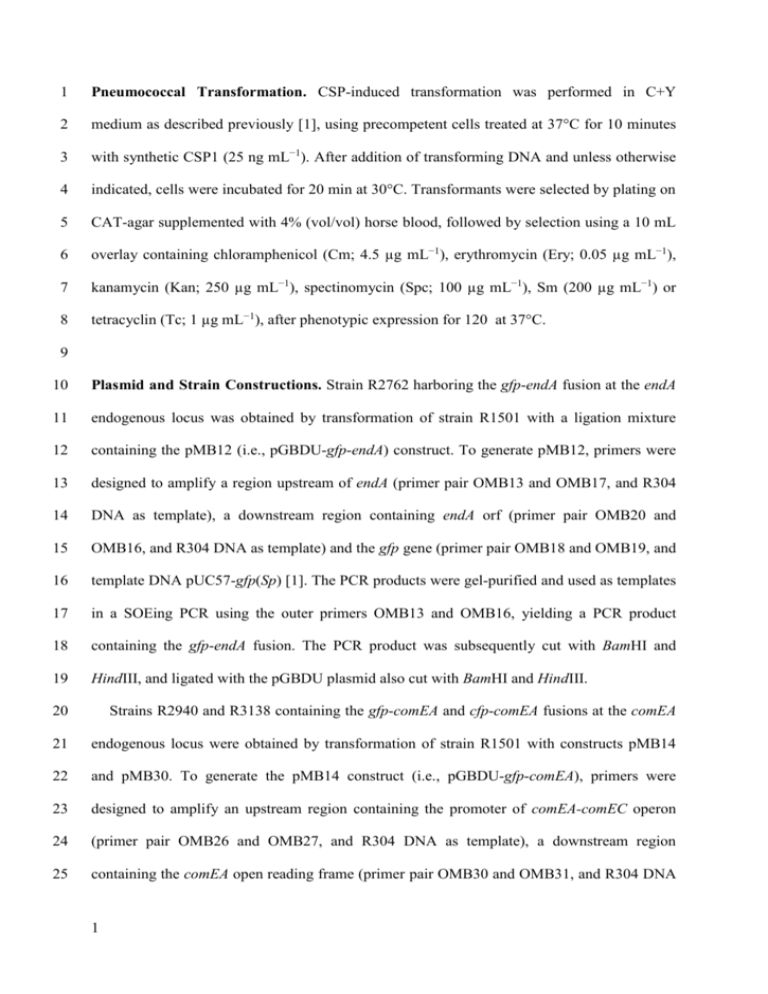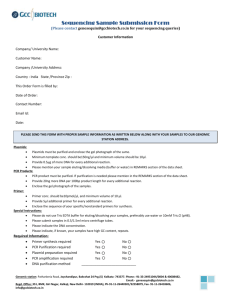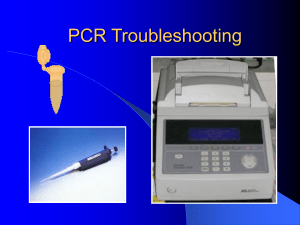Supporting References
advertisement

1 Pneumococcal Transformation. CSP-induced transformation was performed in C+Y 2 medium as described previously [1], using precompetent cells treated at 37°C for 10 minutes 3 with synthetic CSP1 (25 ng mL−1). After addition of transforming DNA and unless otherwise 4 indicated, cells were incubated for 20 min at 30°C. Transformants were selected by plating on 5 CAT-agar supplemented with 4% (vol/vol) horse blood, followed by selection using a 10 mL 6 overlay containing chloramphenicol (Cm; 4.5 µg mL−1), erythromycin (Ery; 0.05 µg mL−1), 7 kanamycin (Kan; 250 µg mL−1), spectinomycin (Spc; 100 µg mL−1), Sm (200 µg mL−1) or 8 tetracyclin (Tc; 1 µg mL−1), after phenotypic expression for 120 at 37°C. 9 10 Plasmid and Strain Constructions. Strain R2762 harboring the gfp-endA fusion at the endA 11 endogenous locus was obtained by transformation of strain R1501 with a ligation mixture 12 containing the pMB12 (i.e., pGBDU-gfp-endA) construct. To generate pMB12, primers were 13 designed to amplify a region upstream of endA (primer pair OMB13 and OMB17, and R304 14 DNA as template), a downstream region containing endA orf (primer pair OMB20 and 15 OMB16, and R304 DNA as template) and the gfp gene (primer pair OMB18 and OMB19, and 16 template DNA pUC57-gfp(Sp) [1]. The PCR products were gel-purified and used as templates 17 in a SOEing PCR using the outer primers OMB13 and OMB16, yielding a PCR product 18 containing the gfp-endA fusion. The PCR product was subsequently cut with BamHI and 19 HindIII, and ligated with the pGBDU plasmid also cut with BamHI and HindIII. 20 Strains R2940 and R3138 containing the gfp-comEA and cfp-comEA fusions at the comEA 21 endogenous locus were obtained by transformation of strain R1501 with constructs pMB14 22 and pMB30. To generate the pMB14 construct (i.e., pGBDU-gfp-comEA), primers were 23 designed to amplify an upstream region containing the promoter of comEA-comEC operon 24 (primer pair OMB26 and OMB27, and R304 DNA as template), a downstream region 25 containing the comEA open reading frame (primer pair OMB30 and OMB31, and R304 DNA 1 26 from as template) and the gfp gene (primer pair OMB28 and OMB29, and template DNA 27 pUC57-gfp(Sp) [1]. The PCR products were gel-purified and used as templates in a SOEing 28 PCR using the outer primers OMB26 and OMB31, yielding a PCR product containing the 29 gfp-comEA fusion under the control of the comEA promoter. The PCR product was 30 subsequently cut with PstI and BamHI, and ligated with the pGBDU plasmid also cut with 31 PstI and BamHI. The ligation mixture was directly used for transformation of pneumococcal 32 cells. The pMB30 construct (i.e., pGBDU-cfp-comEA) was obtained as pMB14 except that a 33 PCR product containing the cfp gene (instead of gfp) was generated using oligonucleotides 34 OMB28 and OMB29, and template DNA pUC57-cfp(Sp). Plasmid pUC57-cfp(Sp) contains 35 the gene encoding eCFP (Clonetech) resynthesized with codons optimized for S. pneumoniae 36 strain R6 (http://gib.genes.nig.ac.jp/) using the OptimumGene™ algorithm and cloned into 37 pUC57 by Genscript USA. Notably, in addition to codon optimization, two modifications 38 were included during synthesis: a nucleotide transition at position 171 (A->T), to inactivate an 39 internal NcoI restriction site, and an amino acid substitution (A206K) that prevents CFP 40 dimerization [2]. 41 To achieve ectopic expression of the yfp-endA fusion in S. pneumoniae, we constructed a 42 derivative of pCEPM, an integrative plasmid that allows chromosomal integration of a gene at 43 CEP and its expression under the control of the maltose inducible promoter PM [3]. Plasmid 44 pMB29 (i.e., pCEPM-yfp-endA) was created in a three-way ligation with an EagI-BamHI PCR 45 product containing endA orf (oligonucleotide OCN5 and OCN6, and R304 DNA as template), 46 a NcoI-EagI PCR product containing the yfp gene with codons optimized for S. pneumoniae 47 (oligonucleotide OMB2 and OMB79, and template DNA pUC57-yfp(Sp)), and pCEPM cut 48 with NcoI and BamHI. The pUC57-yfp(Sp) plasmid contains a yfp variant derived from 49 pUC57-gfp(Sp) [1] with a single point mutation (T203Y) generated by Genscript USA. 2 50 Construction of strain R3741 encoding the GFP-EndAH160A fusion at CEP under PM was 51 first achieved by replacing the yfp gene from the yfp-endA fusion by the gfp variant by 52 transformation of strain R3243 with plasmid pUC57-gfp(Sp). Presence of mutation Y203T in 53 gfp was confirmed by sequencing the gfp-endA orf. Then, to introduce the EndAH160A 54 mutation, primers were designed to amplify the 5’ and the 3’ regions of endA, both including 55 the H160A mutation (primer pairs OCN5 and OMB81 for the 5’ region and OMB86 and 56 OCN6 for the 3’ region, and R304 DNA as template). The PCR products were gel-purified 57 and used as templates in a SOEing PCR using the outer primers OCN5 and OCN6, yielding a 58 PCR product containing the endAH160A mutant gene. This product was directly used to 59 transform pneumococcal cells. Presence of mutation H160A in endA (and Y203T in gfp) were 60 confirmed by sequencing the entire gfp-endAH160A coding region. 61 Strain R3708 harboring the gfp orf fused in frame to the 3’ end of ftsZ, but with a stop 62 codon inserted between the two orfs was engineered as follows. First a strain (R3702) 63 harboring a functional ftsZ-gfp fusion was constructed by transformation of strain R1501 with 64 plasmid pMB39 resulting in integration of the ftsZ-gfp construct at the ftsZ endogenous locus. 65 To generate plasmid pMB39, primers were designed to amplify ftsZ (primer pair OMB94 and 66 OCN52, and R304 DNA as template), the gfp orf together with a linker at its 5’ extremity 67 (primer pair OMB4 and OMB95, and template DNA pUC57-gfp(Sp)) and the ftsZ 68 downstream chromosomal region (primer pair OMB96 and OMB97, and R304 DNA as 69 template). The PCR products containing the ftsZ and gfp genes were subsequently cut with 70 XhoI and ligated. The ligation and the OMB96-OMB97 PCR products were gel-purified and 71 used as templates in a SOEing PCR using the outer primers OMB94 and OMB97, yielding a 72 PCR product comprising the ftsZ-gfp fusion and the downstream chromosomal region of ftsZ. 73 The resulting PCR product was subsequently cut with PstI and BamHI, and ligated with the 74 pGBDU plasmid also cut with PstI and BamHI. Insertion of a stop codon between the ftsZ and 3 75 gfp genes was then achieved by site-directed mutagenesis [4] using primer OMB98 and 76 pMB39 as template generating plasmid pMB40. Plasmids pMB39 and pMB40 were used to 77 transform the S. pneumoniae strains R1818 without selection as previously described [5] to 78 generate strain R3702 and R3708 respectively. Note that the resulting strains contain a hexA 79 mutation negating any effect of the mismatch repair system on transformation efficiencies [6]. 80 Construction of strain R2586 harboring a deletion of the comEC orf was constructed by 81 amplifying an upstream region containing the promoter of the comEA-comEC operon (primer 82 pair OMB7 and OMB8, and R304 DNA as template), the downstream chromosomal region of 83 comEC (primer pair OMB11 and OMB12, and R304 DNA from as template) and the ermAM 84 gene encoding resistance to Ery (primer pair OMB9 and OMB10, and template pR408 [7]). 85 The PCR products were gel-purified and used as templates in a SOEing PCR using the outer 86 primers OMB7 and OMB12, yielding a PCR product containing the comEA-comEC operon 87 with ermAM in place of comEC. The PCR product was directly used for transformation of 88 pneumococcal cells R1501, selecting for EryR transformants. 89 90 Fluorescence Microscopy and Analysis. After gentle thawing of stock cultures, aliquots 91 were inoculated at OD550 = 0.006 in C+Y medium and grown at 37°C to an OD550 of 0.3. 92 These precultures were inoculated (1/100) in C+Y medium and incubated at 37°C to an OD550 93 of 0.06. Then, competence was induced with synthetic CSP1 (25 ng mL−1). At different times 94 after CSP addition, 1 mL samples were collected, cooled down by addition of 500 µL cold 95 C+Y medium, pelleted (3 min, 3,000 g) and resuspended in 50 µL C+Y medium. Two μL of 96 this suspension were spotted on a microscope slide containing a slab of 1.2% C+Y agarose as 97 described previously [8]. 98 Phase contrast and fluorescence microscopy were performed with an automated inverted 99 epifluorescence microscope Nikon Ti-E/B equipped with the “perfect focus system” (PFS, 4 100 Nikon), a phase contrast objective (CFI Plan Fluor DLL 100X oil NA1.3), Semrock filters 101 sets for GFP (Ex: 482BP35; DM: 506; Em: 536BP40), YFP (Ex: 500BP24; DM: 520; Em: 102 542BP27), Cy3 (Ex: 531BP40; DM: 562; Em: 593BP40), a Nikon Intensilight 130W High- 103 Pressure Mercury Lamp, and a monochrome OrcaR2 digital CCD camera (Hamamatsu) or an 104 ImageEM EMCCD camera (Hamamatsu). The microscope is equipped with a chamber 105 thermostated at 30°C. For time-lapse experiments, temperature was set at 37°C. All 106 fluorescence images were acquired with a minimal exposure time to minimize bleaching and 107 phototoxicity effects. Fluorescence images were captured and processed using Nis-Elements 108 AR software (Nikon). YFP, GFP and Cy3 fluorescence images were respectively false 109 colored yellow, green and red, and overlaid on phase contrast images. Two-dimensionnal 110 deconvolution was carried out on fluorescent images using the SVI HuygensEss software v. 111 4.4 (Scientific Volume Imaging B.V., VB Hilversum, Netherlands). Here we used an 112 algorithm based on the Classic Maximum Likelihood Estimator running for 15 iterations and 113 a signal to noise ratio of 30. 114 Images were analyzed with the MATLAB-based open-source software MicrobeTracker 115 [9]. Cell contours were obtained using the alg4 ecoli2 algorithm implemented in 116 MicrobeTracker and parameters spliltTreshold, joindist and joinangle were refined to fit the 117 shape of S. pneumoniae. Fluorescent foci inside the cells were automatically identified using 118 the SpotFinder tool from MicrobeTracker. For each experiment, four fields of several hundred 119 cells, each from three independent experiments, were analyzed. Occasionally, SpotFinder 120 could also detect cells with foci in noncompetent cultures (3 cells over a total of 2,823, Fig. 121 1B). A closer examination of these cells revealed that the shape of the foci were irregular and 122 generally less bright than the ones found in competent cells suggesting that these signals were 123 false positive due to a higher concentration of YFP-EndA fluorescence at the septum which is 124 composed of a double membrane. To plot the distribution of fluorescent foci along 5 125 longitudinal cell axis, distances of foci from one pole were recorded as a function of cell 126 length in relative coordinates extending from 0 at the pole to 0.5 at midcell. The distributions 127 were plotted as the percentage of total foci versus cell length. All statistics were calculated 128 using Graphpad Prism 4. Statistical significance was determined using a two-tailed Mann- 129 Whitney test (p = 0.0003). 130 131 132 133 134 135 136 137 138 139 140 141 142 143 144 145 146 147 148 149 150 151 152 153 154 155 156 157 158 Supporting References 1. Martin B, Granadel C, Campo N, Henard V, Prudhomme M, et al. (2010) Expression and maintenance of ComD-ComE, the two-component signal-transduction system that controls competence of Streptococcus pneumoniae. Mol Microbiol 75: 1513-1528. 2. Zacharias DA, Violin JD, Newton AC, Tsien RY (2002) Partitioning of lipid-modified monomeric GFPs into membrane microdomains of live cells. Science 296: 913-916. 3. Guiral S, Henard V, Laaberki MH, Granadel C, Prudhomme M, et al. (2006) Construction and evaluation of a chromosomal expression platform (CEP) for ectopic, maltosedriven gene expression in Streptococcus pneumoniae. Microbiology 152: 343-349. 4. Shenoy AR, Visweswariah SS (2003) Site-directed mutagenesis using a single mutagenic oligonucleotide and DpnI digestion of template DNA. Anal Biochem 319: 335-336. 5. Quevillon-Cheruel S, Campo N, Mirouze N, Mortier-Barriere I, Brooks MA, et al. (2012) Structure-function analysis of pneumococcal DprA protein reveals that dimerization is crucial for loading RecA recombinase onto DNA during transformation. Proc Natl Acad Sci U S A. 6. Claverys JP, Lacks SA (1986) Heteroduplex deoxyribonucleic acid base mismatch repair in bacteria. Microbiol Rev 50: 133-165. 7. Prudhomme M (2007) In vitro mariner mutagenesis of Streptococcus pneumoniae: tools and traps. In: Hakenbeck R, editor. The Molecular Biology of Streptococci. Norwich, UK: Horizon Scientific Press. pp. 511-517. 8. de Jong IG, Beilharz K, Kuipers OP, Veening JW (2011) Live Cell Imaging of Bacillus subtilis and Streptococcus pneumoniae using Automated Time-lapse Microscopy. J Vis Exp. 9. Sliusarenko O, Heinritz J, Emonet T, Jacobs-Wagner C (2011) High-throughput, subpixel precision analysis of bacterial morphogenesis and intracellular spatio-temporal dynamics. Mol Microbiol 80: 612-627. 6








